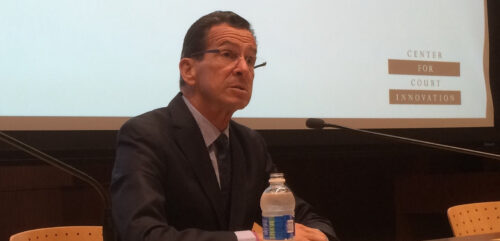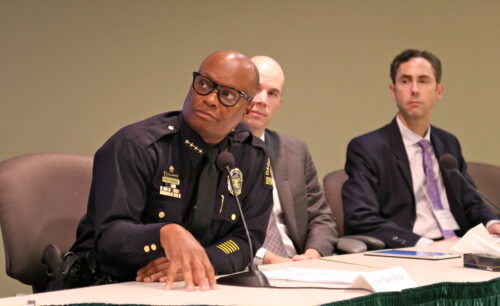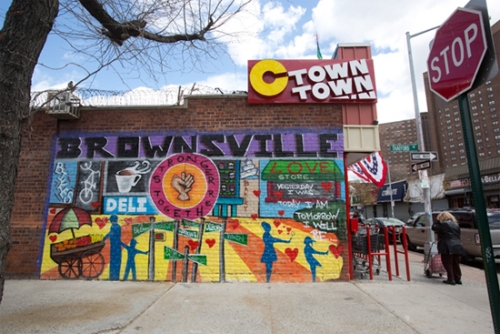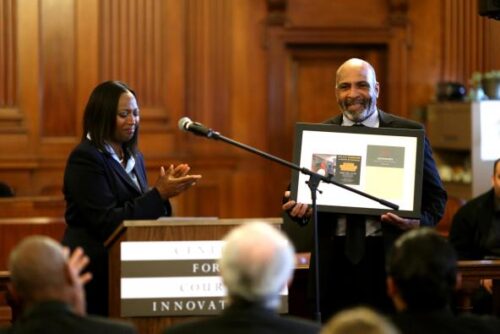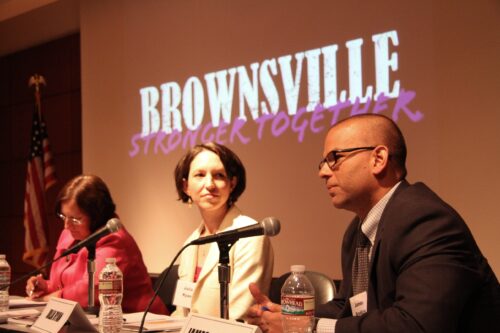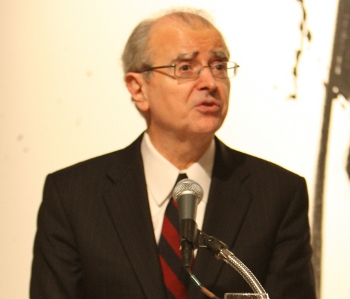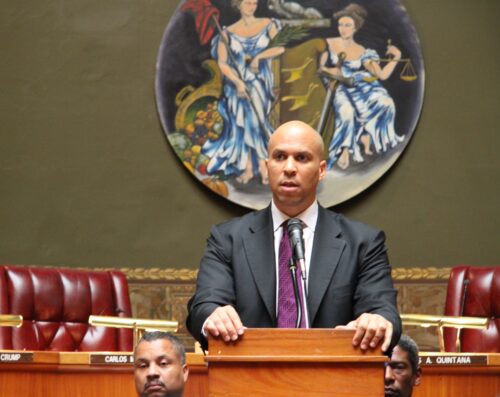Seattle Community Court supplies creative solutions for high-impact, low-level crime
A crime is ruled de minimus if it is considered too small to be cause for concern. But when a crime is committed over and over, can it still be considered a trifle?
“Is it still de minimus if a hundred sandwiches are taken?” asked Judge Fred Bonner, who presides over the Seattle Community Court. Bonner says that people who are in survival mode are going to commit acts of theft to survive, and often these small crimes indicate larger societal problems far from trifling.
Seattle had been struggling with low-level crime, such as theft and prostitution, and many of the people committing these crimes were homeless or mentally ill. The closure of two mental hospitals in the area, as part of the national deinstitutionalization movement in the 1980s, further exacerbated Seattle’s problem. “Criminal trespass, theft, prostitution, alcohol and drug-related crime—those were the main kinds of crimes we were dealing with,” said Assistant City Attorney Tuere Sala. “They are what we call quality-of-life crimes—and they are usually crimes that are committed more out of a need to survive than an intention to injure others.”
And while the intention may not have been to injure any one individual, the cumulative effect of this kind of offending on a community can be devastating. “Even if you think it’s a faceless crime,” said defense attorney Nancy Waldman, of the Associated Counsel for the Accused, “somebody is violated. If a business feels that way, they’re more inclined to move their business away from any given district. It has an effect on the whole city.”
A Non-Partisan Issue
Seattle City Attorney Peter S. Holmes said, “This is a non-partisan issue: Everyone wants to reduce crime and save money, and that’s ultimately what community court is about.”
In the search for an appropriate response to Seattle’s low-level crime, then-City Attorney Tom Carr and then-Chief of the Public and Community Safety Division Robert Hood learned about the community court model, which can often apply problem-solving approach to quality-of-life offenses. In March 2005, through the collaborative efforts of the Seattle Municipal Court, the Seattle City Attorney, and the Associated Counsel for the Accused, the Seattle Community Court opened in the municipal court building to serve the downtown district. “We took those individuals who had no place to go, who had spent many days in jail over the years,” said Judge Bonner, “and we designed our program to address those needs.”
Like most community courts across the U.S., by combining punishment with help, the Seattle Court seeks to address the social needs associated with crime, repair the harm done, and help transform offenders into productive members of the community. The Seattle Court has had over 3,000 clients since its 2005 opening, and in 2007 the court expanded its jurisdiction from downtown to the entire city.
The Seattle Community Court handles only defendants who have committed low-level misdemeanors and do not present a public safety risk. In lieu of paying a fee or spending time in jail, all defendants who opt in to the community court are assessed for social service needs and then must contact each social service link, such as community service opportunities identified during assessment. It is common practice in community courts to use alternatives to detention, such as community service as a sanction—participants in the Seattle Court have completed over 50,000 hours of community service, the equivalent of approximately $500,000 worth of labor—but Judge Bonner stresses the importance of evolving these programs to also educate people about the effects quality-of-life crime has on the community. “We want to teach as well,” Bonner added, “and they can earn [community service] hours by learning about the impact their offenses have had on the business community. We could send everybody to be street sweepers, but that is not necessarily addressing the needs that they have.” If offenders successfully complete the program, their case can be dismissed, which will later come into play when they are seeking housing and employment. Additionally, the Resource Center, which is on site, helps to further connect clients of the court to information about jobs, housing, counseling, and classes to help them get back on track.
A Capacity to Change
Seattle continues to develop their programs and services to address the needs of offenders as those needs change. “We've just developed a theft awareness class and life-skills training, which would constitute community service,” said Judge Bonner, who added that Seattle Community Court also recently launched three stand-alone sites that provide young prostitutes with housing and classes on avoiding sexually transmitted diseases. They can earn community service hours at these sites, as well as get literacy training and counseling.
Seattle Community Court is also currently instituting new protocols that allow for community service alternatives for individuals with disabilities. The court already partners with 25 community service organizations, and coordinators from the Seattle Community Court have recently started to expand options to include other options for individuals not physically able to pick up trash, such as answering phones or filing. “Offenders find that they feel proud of putting in a full day’s work,” said Karen Murray, of the Associated Counsel for the Accused. “Then we can link them to employment services. Landlords and employers can see people’s capacity to change.”
Seattle Community Court is also evolving to address the different needs that veteran offenders have. “We have a marvelous caseworker from the veteran’s hospital coming to our court, and we’re trying to do a docket right now just for veterans,” said Murray. “They never had criminal histories before and suddenly they’re coming back and they’re acting out. Do we actually expect people to get off the plane and come back into society as though nothing happened? That’s another role for community court in our time.”
Another defining element of our time is the strained economic climate experienced throughout the country, and community courts are not immune to this struggle. “We have been suffering some serious budget issues here,” said Judge Bonner, “but one of the things that the city council has said is, ‘We don’t want to reduce or cut community court.’ It has been recognized that not only does it save the city money, it also saves lives.”
Results
In 2009, the Justice Management Institute issued an independent evaluation of Seattle Community Court. The report stated that the community court group committed 66 percent fewer offenses within 18 months of community court intervention, while the control group showed an increase of 50 percent, suggesting that the court is significantly more effective at reducing the frequency of recidivism than the traditional court process. “The study adds to the value of understanding these kinds of interventions; even though they seem at the surface to be cost-intensive, that may actually not be the case,” said Elaine Nugent-Borakove, president of the Justice Management Institute and primary researcher on the evaluation. Furthermore, the Seattle Mayor’s Office of Policy and Management estimates that through reduced recidivism and jail use the community court saved the city $1,513,209 during the court’s first three years of operation.
“We’re still studying why crime is down nearly double digits percentagewise in Seattle over the past 16 months,” said City Attorney Holmes, “but I have to think that community court is a factor.” Holmes also discussed how community court may have helped alleviate the strain on funds. “When I was on the campaign trail in 2009, it was seen as inevitable that Seattle was going to break ground on a new jail with a price tag of 400 million dollars within the next five years. We have to give some credit to the community court diverting people from incarceration to the fact that Seattle is no longer seriously on the track to build a new jail.”
A Mentor Community Court
As Seattle Community Court continues to evolve to more appropriately address the needs of the community, the program is also working to help other jurisdictions interested in starting their own community courts. In 2009, through a competitive, peer-reviewed process, Seattle Community Court was selected, along with South Dallas Community Court and Hartford Community Court, to become a mentor community court. Mentor community courts work with the Center for Court Innovation to provide guidance to jurisdictions across the country interested in creating community courts to help combat neighborhood crime. Seattle has recently provided information to jurisdictions including Spokane, Washington, Kent, Washington, and Las Vegas, Nevada.
“Don’t use the austere budget climate as an excuse not to move forward,” said Holmes, when asked what advice he would give jurisdictions considering starting a community court. “This is ultimately cost-saving and much more effective than the tradition incarceration route. It really just takes political will. Go ahead and make the small step.” Holmes added that establishing data capture systems that show the benefits of the community court model in contrast with the typical incarceration model is a key step to establishing a community court in the long-term.
An Evolving Partnership
For some who work in the court, the problem-solving approach is new. Craig Sims, chief of the Criminal Division, said: “When I came here in January 2010, I didn’t know much about community court. I’ve been a prosecutor since the late nineties, working in the traditional mode of prosecution: Someone does something wrong, they go to court, they get prosecuted, they go to jail, and we move on to the next one. It was quite refreshing for me to collaborate with the court and the defense to figure out a different way to resolve lower level crimes.”
“We’re all partners in this,” added Holmes, and the Seattle community can see the tangible the benefits of this partnership. “We’ve had some wonderful public events,” said Holmes. “Rather than spending time in jail, low-level offenders were out beautifying the community and giving back. Community murals have had unveiling events, heavily attended by local community groups and local media, and the community is able to feel less cynical about the criminal justice system.”
“I like the fact that it’s an opportunity court,” said Sala. “You have an opportunity to make a difference, to change something. As a prosecutor, I would rather see that than the same offenders constantly coming back.”
Waldman added: “That’s the definition of insanity, right?—doing the same thing over and over and expecting different results.”
“Everyone has a story,” Murray said. “Some are more horrific than others. But the bottom line is there’s a thing called choice. Community court gives our clients the choice to be successful.”
